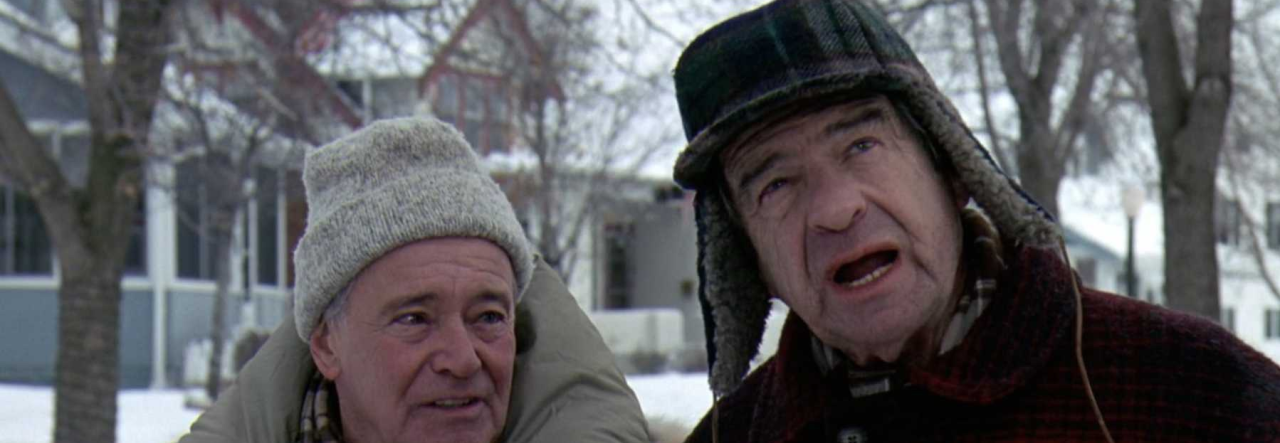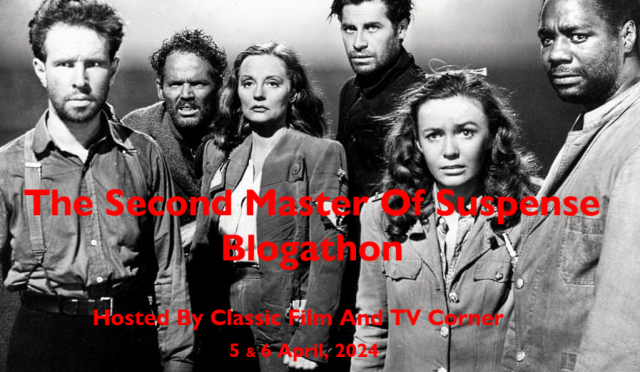I first saw The Birds in the 90s when I was in middle school. It was supposedly “very scary” but I didn’t find it scary in the slightest. In fact, back then and even now, I find parts of it very funny. Because of Hitchcock’s known fondness for macabre humor, it’s hard to know whether Hitchcock purposely intended for these scenes to be funny. There are also parts of this film that I find very bewildering. I also love the birds in The Birds and think that they are 100% the heroes of the film.
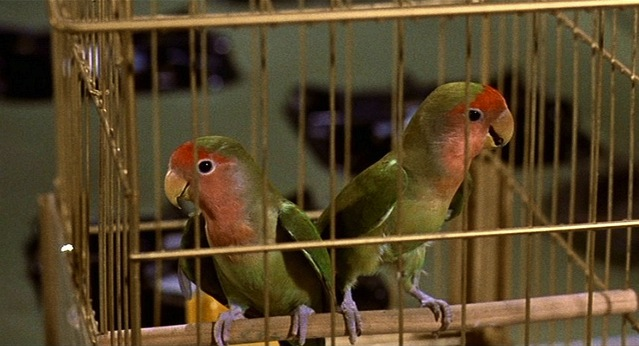
The Birds, based on Daphne du Maurier’s 1952 short story of the same name, starts with socialite and known party girl, Melanie Daniels (Tippi Hedren) in a San Francisco pet shop. She seems to just be browsing. The shop proprietor, Miss Inch from The Parent Trap, steps away for a second. While she’s out of earshot, lawyer Mitch Brenner (Rod Taylor) enters the shop looking for a pair of lovebirds for his sister Cathy’s (Veronica Cartwright) birthday. Mitch recognizes Melanie as the party girl whose picture he saw in the newspaper. It seems she had been arrested for pulling a practical joke and due to her notoriety as a raucous socialite, she made the local newspaper. Knowing that she doesn’t work at the pet shop, Mitch pretends to mistake her as an employee and asks her technical questions about birds. She tries to pretend that she knows about birds, but fails. Mitch tells her that he knows about her and leaves. Resenting that Mitch made her out to be a fool, Melanie purchases the lovebirds and decides to deliver them to Mitch herself.

Melanie ends up following Mitch to his weekend home in Bodega Bay, about an hour outside of San Francisco. When she arrives in town, she asks around town for the location of Mitch’s home as well as the name of his sister. She’s directed to the home of the local school teacher, Annie Hayworth (Suzanne Pleshette) who is Cathy’s teacher. In addition to learning Cathy’s name, she also learns that Annie is Mitch’s ex-girlfriend who broke up with Mitch over his overbearing mother, Lydia (Jessica Tandy). Melanie also earns an invitation to stay with Annie at her home. As an aside, the whole Mitch/Lydia dynamic is odd. First of all, she seems much too old to be Cathy’s mother. It would be more believable if Cathy were Mitch’s daughter. This change in the storyline wouldn’t affect the plot. But aside from that, there are also scenes between Mitch and Lydia, where they oddly seem like romantic partners versus mother and son. I find some of their scenes strange.
Anyway, Melanie ends up renting a boat and rowing across the bay to Mitch’s farmhouse. She breaks into his home and delivers the lovebirds. She then returns to her boat so she can wait for Mitch to enter the home and find the lovebirds. He does and quickly finds Melanie. When Lydia meets Melanie, she is cold to her, because she resents any woman in her son’s life. She is very much the jealous lover even though she’s Mitch’s mother. Anyway, it is after Melanie’s burglary of Mitch’s home is when the birds start attacking!
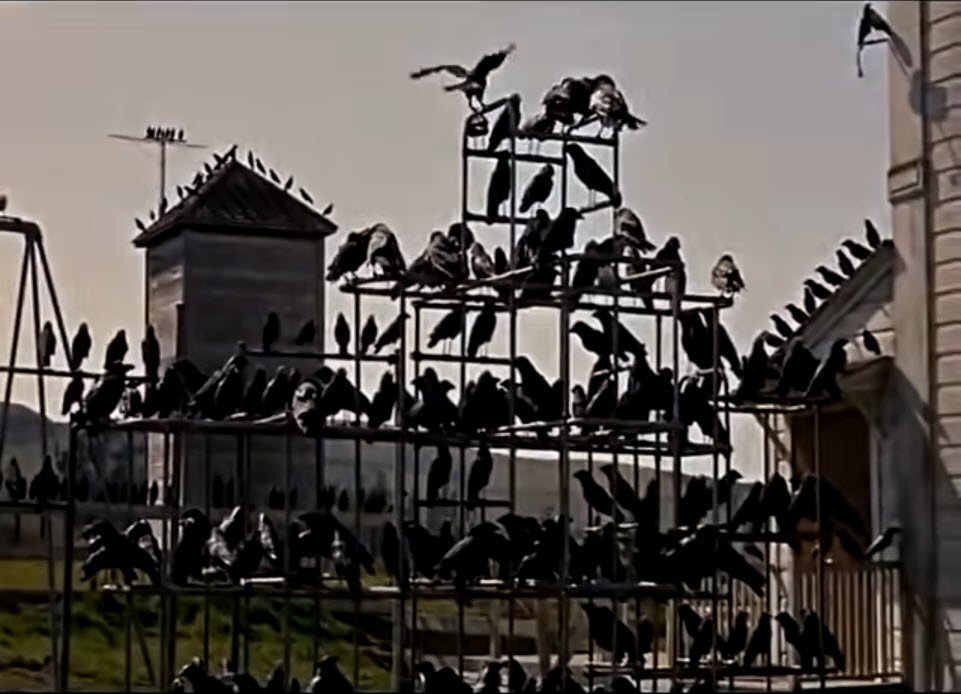
Melanie is hit by a seagull upon returning to shore to return the boat. Mitch sees her and tends to her injury. Later, the children at Cathy’s birthday party are attacked by a flock of birds. Throughout the film, there are random bird attacks, which are unexplained. Never once in Hitchcock’s narrative does he try to offer a rational explanation for the bird attacks. The randomness and severity of the attacks is what lends the horror to The Birds. Hitchcock also opted to not use any sort of soundtrack or score, instead choosing to only utilize the sound of the birds to punctuate the action in the film. There are also large chunks of the film where there is no sound at all, except the diegetic and ambient sounds present within the film.

The absolute best example of Hitchcock’s use of silence and specific diegetic and ambient sounds is in the climactic scene when the birds attack the children at the school. To get this off my chest, I have to say that the song that the kids sing is so annoying and so awful, that I don’t blame the birds for attacking. The birds were doing the audience a favor. That song is irritating. I applaud the birds for putting an end to it. This is why they are the heroes of the film. Hitchcock also uses silence and diegetic sound very effectively at the film’s end, when the Brenner family walks an injured Melanie out of the house into the car, while the birds sit perched in silence. It’s very eerie and uncomfortable.
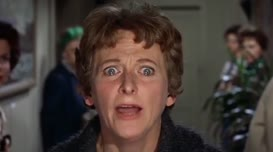
Earlier in this article, I mentioned there are scenes that I find funny. Some scenes I think are intentionally funny, like the lovebirds leaning into every curve while Melanie is driving. One scene that I doubt is supposed to be funny but is funny is the scene when Mitch and Melanie are trying to find Cathy after the bird attack at the school. They go to Annie’s home and find Annie dead on the stairs, victim of the bird attack. Then, Melanie asks “Where’s Cathy?” Suddenly, Cathy pulls open the curtains and is sobbing in the window. For whatever reason, Cathy’s hysterical crying combined with the dramatic curtain pull makes me laugh. I know that’s probably terrible. Unfortunately, I cannot find a photo of Cathy in the window to support my statement. The other part that makes me laugh is the distressed mother in the diner. I also love that the other diners, like the bird lady, casually discuss the murderous birds. The distressed mother’s children are unaffected by the talk, but the mother is determined that her children are scared to death. I choose to believe that this mother deserves the stress as payback for wrecking Henry Fonda and Vera Miles’ lives with her false accusations in The Wrong Man.
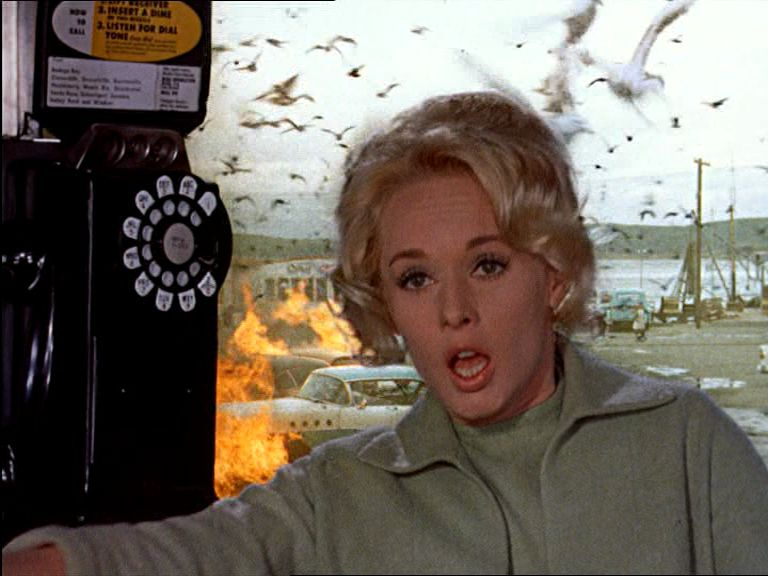
One of the highlights of The Birds is the big explosion at the gas station. The birds attack a gas station attendant and he and the other employees run inside. Because of the attack, the gas attendant drops the gas hose on the ground, leaving a trail of gasoline. The birds start to attack and Melanie takes refuge in a phone booth. The scene of Melanie in the phone booth with birds hitting the glass walls is one of the famous scenes in the film. This scene concludes in spectacular fashion with a customer lighting a cigar at the gas station, igniting the massive trail of gasoline. A huge explosion levels the gas station. Melanie returns to the diner. Then, the distressed mother launches into her diatribe, accusing Melanie of bringing about the bird attacks and being evil.
MOTHER: Why are they doing this? Why are they doing this? They said when you got here, the whole thing started. Who are you? What are you? Where did you come from? I think you’re the cause of all of this. I think you’re evil. EVIL!
Doreen Lang as “Hysterical Mother in the Diner” in The Birds (1963)
I love that The Birds does not have a resolution. As far as we know, the birds are still out there, running Bodega Bay.

